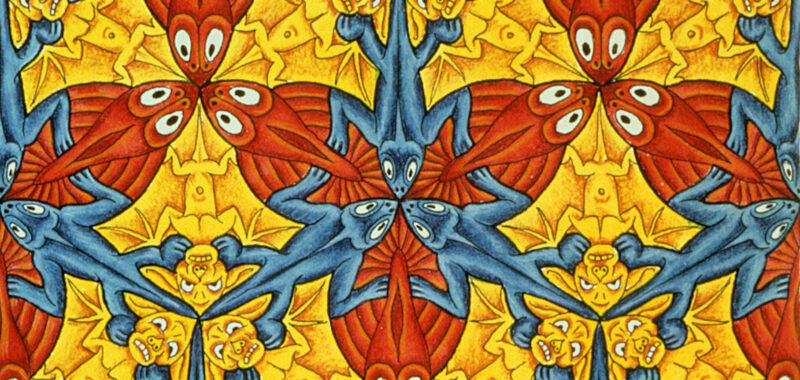
Alongside Monet’s water lilies and van Gogh’s swirling night sky, the telescoping staircases and precise forced perspectives of M.C. Escher are some of the most identifiable motifs in the Western art canon. Escher, a new book edited by Mark Veldhuysen and Federico Giudiceandrea and published by Skira, is a densely illustrated compendium of the artist’s life work. While it includes some of his greatest hits, it also brings to light lesser-known and previously unpublished pieces from his oeuvre.
The book traces the Netherlands-born Escher from his origins through his education and the actualization of his unique vision, culminating in the “Eschermania” that has preserved and proliferated that vision. Work made during his years post-schooling is given particular focus, rooting his obsessions with precise geometries, puzzle art, tessellation, and paradox in his early life in the 1920s, which was also a deeply influential time in Italy.

Escher first encountered Italy via its Mediterranean coast in 1921, at the age of 22, while on a trip with his parents during a college break. Following his graduation, he embarked on a “Grand Tour,” an upper-crust European tradition, which included a return to Italy, this time Tuscany. According to a catalogue essay by Giudiceandrea, this was when Escher fell in love with the Italian landscape, as well as experienced modern art for the first time during a visit to the 13th Venice Biennale, which featured a retrospective dedicated to Amedeo Modigliani. Escher eventually returned in 1924 to settle in Rome — a period that was not only a curative for his generally melancholic personality, but also brimming with architectural, philosophical, and artistic influences that would directly inform his developing style. Escher continued to live and work in Italy through 1935.

During this time, Escher was still a naturalistic illustrator, rather than the optical illusionist he would become. Numerous studies from this period depict the architecture of surrounding cities and the Italian countryside, forming the jumping-off point of the intricate prints he would later create in his studio by combining several perspectival views of the same landscape to form enigmatic compositions.


Spheres and their perspective-bending properties were a common motif for Escher throughout his career, as exemplified in one of his most famous self-portraits, in which the artist beholds his own distorted reflection in a mirrored ball. But other illustrations, such as his Circle Limit series (c. 1958–60), reveal this predilection as a potential tribute to the domed and highly decorated cathedral ceilings that he must surely have encountered within the churches of Vatican City, the founding of which occurred while Escher lived in Italy. The book also includes Nocturnal Rome (1934), a series of 12 woodcuts created by the artist based on his nighttime wanderings through the city.

“In the evening from 8am to 11 or 12 at night, I sketched in Rome, in this amazing, beautiful, night-time Rome, whose architecture I love so much more than I do during the day,” Escher wrote in a 1940 letter to critic G.H. ‘s-Gravesande. “All the excessive Baroque elements with which Rome is inundated (Rome is after all a Baroque city par excellence, despite the Roman and Medieval remains) fade at night.”
Though the book ranges far beyond Escher’s early work, it offers detailed insight into the influence of a place so close to the artist’s heart and so informative to his process. It’s a fitting way to revisit an iconic artist, since — as Escher himself might say — every subject can benefit from additional perspective.




